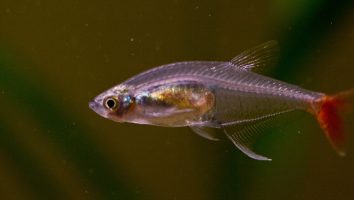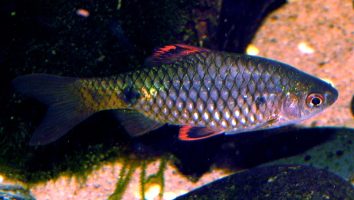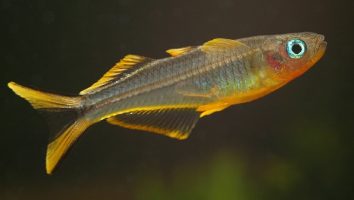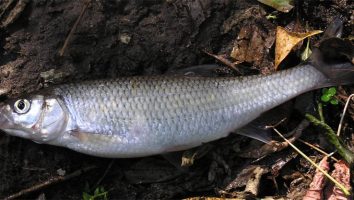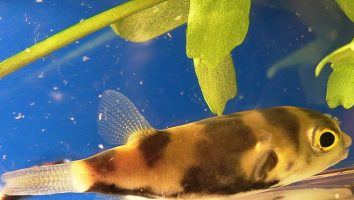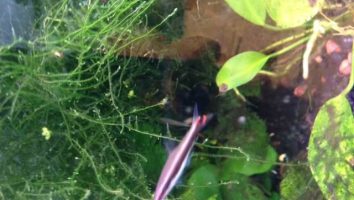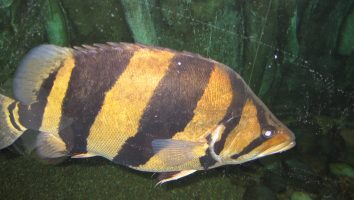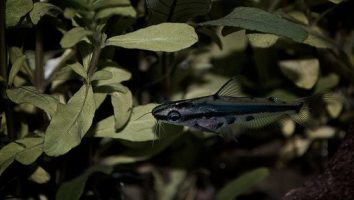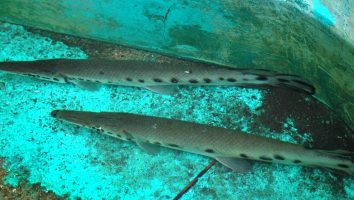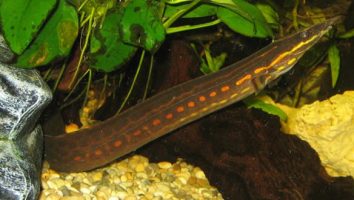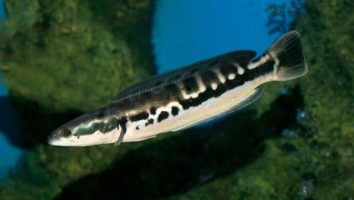The upside-down catfish is a popular freshwater fish that is known for its unique swimming style… well, unique for a fish at least.
This guide will teach you everything you need to know about upside-down catfish care. You’ll learn about their diet, size, lifespan, and more!
Table of contents
Species overview
The upside-down catfish (scientific name: Synodontis nigriventris) is a type of catfish that’s native to Africa. It gets its name from its habit of swimming upside down!
These fish are found in a wide range of habitats, but they seem to prefer slow-moving water with a lot of vegetation. This could be due to the fact that it’s easier for them to find food in these areas.
Upside-down catfish are omnivores, which means that they’ll eat both plants and animals. In the wild, their diet consists mostly of insects and other small invertebrates.
These fish are popular in the aquarium trade because of their unique swimming style and their peaceful nature. They are compatible with a wide variety of tank mates and make a great addition to most community tanks.
Appearance
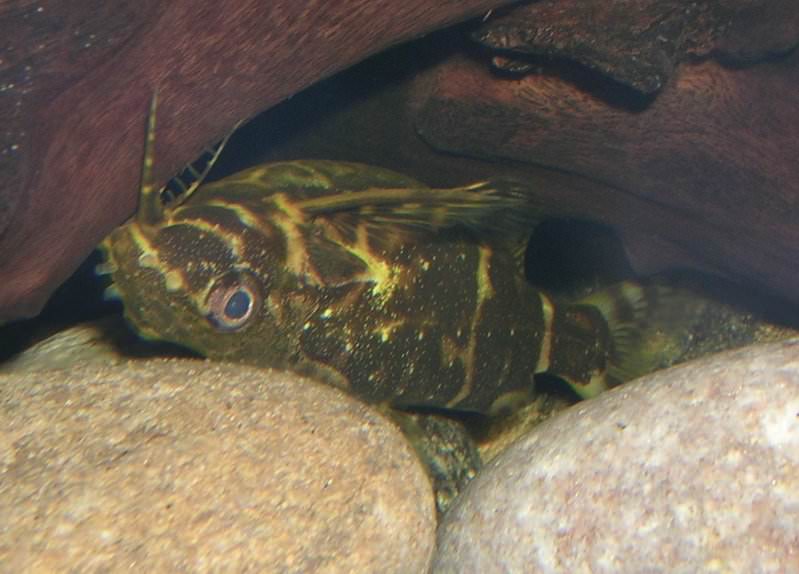
As you can probably tell from their name, upside-down catfish are a bit different when it comes to their appearance. The first thing you’ll notice is that they tend to swim upside down most of the time (this is how they get their name).
While this may seem like a disability, it’s actually quite normal for this species. In the wild, they use this swimming method to look for food as well as to avoid predators.
These fish are a bit small, only growing to be about four inches in length when fully mature. They have a brown or black coloration with a white or cream-colored belly.
Their dorsal fin is rather small and shorter than their anal fin. They have a forked caudal fin that’s the same height as their body.
One of the most interesting things about this fish is their eyes. They’re very large in comparison to their heads and are located on the top of their heads. This helps them see better while they’re swimming upside down.
Lifespan
The average lifespan of an upside-down catfish is 5 to 10 years. These fish are actually quite long-lived compared to other freshwater fish.
As with most fish, there are a number of factors that can impact their lifespan. Things like water quality, diet, and stress can all shorten their life expectancy.
Size
The average upside-down catfish size is about 4 inches long when fully grown. These fish are relatively small compared to other aquarium fish, making them a good choice for smaller tanks.
Tank
Tank Size
The recommended tank size for upside-down catfish is at least 20 gallons for a single fish and 30 gallons if you plan on keeping a group of them.
As with most fish, it’s always best to give them a little more room than the minimum recommended tank size. This will allow them to feel more comfortable and reduce the risk of aggression.
Water Parameters
The upside-down catfish is a tropical freshwater fish that does best in an aquarium that has been set up to mimic its natural habitat. That includes replicating the water conditions of the Amazon River basin.
The upside-down catfish is a relatively easy fish to care for, but you still need to maintain consistent water conditions. That’s the key to success with any fish, really.
Here are a few general guidelines for the water parameters of your upside-down catfish aquarium.
- Water temperature: 72 to 82 degrees Fahrenheit
- pH levels: 6.5 to 7.5
- Water hardness: 5 to 15 dGH
- Alkalinity Levels: 4 to 8 dKH
What To Put In Their Tank
The first thing you need to do when setting up an aquarium for an upside-down catfish is to figure out what kind of substrate you want to use.
These fish love to burrow and hide, so you need something that they can easily do that in. We prefer to use a soft, sandy substrate for this reason.
The next thing you need to do is add some plants. These fish love to hide among the foliage, so you need to give them plenty of places to do that.
We recommend using a mix of live and artificial plants. The live plants will help to keep the water quality high, and the artificial plants will provide the fish with plenty of places to hide.
You also need to add some driftwood or rocks to the tank. These fish love to hide under things, so you need to give them plenty of places to do that.
Just be sure that the driftwood and rocks are firmly planted in the substrate. These fish are notorious for knocking things over, and you don’t want them to hurt themselves.
Common Diseases
While the upside-down catfish is a fairly hardy fish, there are still a few diseases that you should be aware of.
The most common one is ich, which is a parasite that can cause your fish a lot of stress (and even death).
The most obvious sign of ich is the presence of white spots on the body of your fish. If you notice this, it’s important to act fast and begin treatment immediately.
Other potential diseases include bacterial infections, fungal infections, and parasites. These are all fairly common in the world of freshwater fishkeeping, so it’s important to be aware of the signs.
The best way to prevent your upside-down catfish from getting sick is to maintain a clean and stable tank. This will create an environment that is less conducive to disease and will help your fish stay healthy.
Behavior & Temperament
The upside-down catfish is a unique creature that is known for, you guessed it, swimming upside down! This is a relatively new species to the aquarium world, so not much is known about their behavior and temperament.
What we do know is that they are very peaceful fish. They get along with other fish, and they don’t have any aggression towards people.
These fish are also known to be very curious. They’ll often swim up to the glass to check you out!
Besides their interesting swimming habits, not much is known about the upside-down catfish. They are a relatively new species, so more research needs to be done in order to learn more about their behavior and temperament.
Tank Mates
In the wild, upside-down catfish are found in slow-moving rivers and streams. This is where they do the majority of their foraging.
They’re not known to be aggressive and actually do quite well in community tanks.
The main thing to watch out for is making sure that your tank is big enough. Because these fish grow to be fairly large (up to 6 inches), they need plenty of space to swim.
A 30-gallon tank is the bare minimum for a single fish. If you want to add more than one, you’ll need an even larger tank.
Upside-down catfish are also known to be a bit skittish. As a result, it’s best to avoid tank mates that are too active or aggressive.
Here are some compatible species to consider:
- plecos
- Corydoras catfish
- Otocinclus catfish
- Loricariids
- Synodontis catfish
- Knifefish
- Dwarf gouramis
- Angelfish
- Rams
Breeding
The biggest challenge you’ll face when breeding Upside-down Catfish is getting them to mate in the first place. They’re a bit picky when it comes to their breeding partners.
The best way to find a compatible pair is to buy a group of juveniles and let them pair off naturally. If you can’t do that, look for a male and female that are around the same size. Avoid any that look like they might be related.
Once you’ve found a pair, put them in a breeding tank. It should be at least 30 gallons and have a lot of hiding places. Be sure to use a sponge filter to keep the fry safe.
The water should be around 80 degrees Fahrenheit with a neutral pH.
When ready, the female will lay her eggs on a leaf or piece of driftwood. The male will then fertilize them. After that, he’ll stay close by to protect them.
The eggs will hatch in about a week. When they do, remove the adults and begin feeding the fry live food. They’ll need to be fed several times a day to survive.
Conclusion
The upside-down catfish is a great addition to any freshwater aquarium. They are relatively easy to care for and are very peaceful fish.
They are also very active fish and will often be seen swimming upside down at the top of the tank. This is one of the reasons why they are such a popular fish.
Overall, we would highly recommend this fish to anyone looking for a new addition to their tank.

